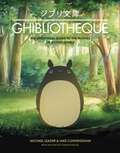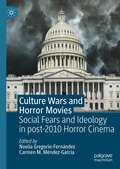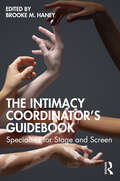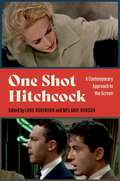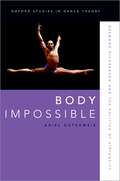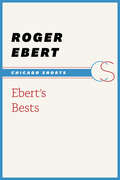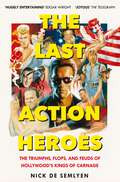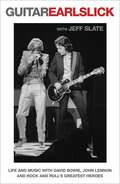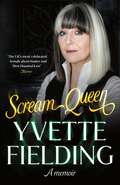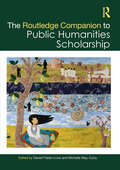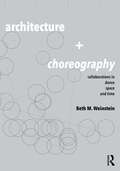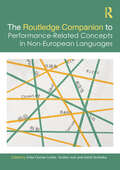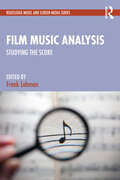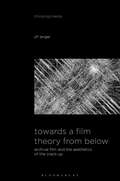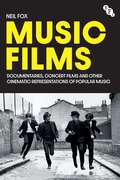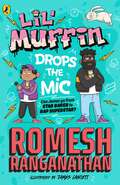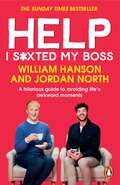- Table View
- List View
Ghibliotheque: The Unofficial Guide to the Movies of Studio Ghibli
by Jake Cunningham Michael LeaderRevised and updated - includes Miyazaki's new masterpiece, The Boy and the Heron.Explore the films of magical Japanese animation masters Studio Ghibli in this film-by-film celebration for newcomers and long-time fans alike.Ghibliotheque reviews each Studio Ghibli movie in turn, in the voice of expert and newcomer. The lively text delves into production details, themes, key scenes and general reviews, as well as Ghibli-specific information. It's beautifully illustrated with stills and posters from each movie.Written by the hosts of the acclaimed Ghibliotheque podcast, this is the first and last word on the films of Studio Ghibli.
Culture Wars and Horror Movies: Social Fears and Ideology in post-2010 Horror Cinema
by Noelia Gregorio-Fernández Carmen M. Méndez-GarcíaIn this volume, contributors explore the deep ideological polarization in US society as portrayed in horror narratives and tropes. By navigating this polarized society in their representation of social values, twenty[1]first-century horror films critically frame and engage conflicting and divisive ideological issues. Culture Wars and Horror Movies: Social Fears and Ideology in Post-2010 Horror Cinema analyses the ways in which these “culture wars” make their way into and through contemporary horror films, focusing on the post-2010 US context and its fundamental political divisions.
The Intimacy Coordinator's Guidebook: Specialties for Stage and Screen
by Brooke M. HaneyThe Intimacy Coordinator's Guidebook: Specialties for Stage and Screen explores the role of the intimacy choreographer with an in-depth look at specializations that exist within the profession.With contributions by over 30 industry professionals, this book aims to bring awareness to a wide range of needs a project may have and how intimacy professionals use their cultural competency specialists in practice to create the most compelling storytelling. In Part One, the book addresses the scope of practice of an intimacy professional by discussing competency, finding your lens and tangential fields in the industry like fight directors, mental health coordinators and cultural competency specialists. Part Two covers specialties like working with minors, prosthetics, intimacy and disability, staging queer intimacy, working with fat actors, Black American intimacy, dance, working on scenes of trauma, sexual violence and non-consent, and BDSM. Between each chapter is a conversation with an actor, director or producer on their experiences working with an intimacy coordinator. In Part Three, the book looks at what it means to be qualified and intimacy professionals' hopes for the future of the industry.The Intimacy Coordinator's Guidebook is an invaluable resource for directors and producers looking to hire an intimacy professional, as well as in-depth study for those who are training or practicing in the field of intimacy for performance.
One Shot Hitchcock: A Contemporary Approach to the Screen
by Luke Robinson and Melanie RobsonIn recent years, the enduring appeal of Alfred Hitchcock to film studies has been evidenced by the proliferation of innovative approaches to the director's work. Adding to this pattern of innovation, the edited collection One Shot Hitchcock: A Contemporary Approach to the Screen utilizes formal analysis to interrogate key single shots from across Alfred Hitchcock's long career. This collection reveals the value of analyzing the single shot - within this small, cinematic unit is a code that unlocks a series of revelations about cinema as an artistic practice and a theoretical study. Each chapter examines one shot from a single film, beginning with The Lodger (1927) and ending with Frenzy (1972). If Hitchcock is known as a director of suspense films and films about murder, the shots discussed in One Shot Hitchcock are his crime scenes. These are the shots that resist being forgotten, that repeatedly demand to be investigated, in which Hitchcock's influence on aesthetics and culture is at its most acute. Each chapter uses a different lens of film analysis - transnationalism, gender and sexuality, performance, history, affect, intermediality, remake studies, philosophy, and film form are all used to interrogate single shots. In these essays, the single shot from Hitchcock's film not only illustrates the approach in question but also demonstrates how the single shot encourages us to rethink our approaches to the screen. By reinvigorating a close formal mode of analysis, One Shot Hitchcock asks readers to think differently about film, offering a renewed assessment of Hitchcock's oeuvre in the process.
Body Impossible: Desmond Richardson and the Politics of Virtuosity (Oxford Studies in Dance Theory)
by Ariel OsterweisBody Impossible theorizes the concept of virtuosity in contemporary dance and performance through a study of the career of dancer Desmond Richardson. A virtuoso for the ages, Richardson is renowned for delivering commanding performances over decades in contexts ranging from the stages of the Alvin Ailey American Dance Theater and Ballett Frankfurt to featured appearances with Michael Jackson and Prince, along with his work as co-founder of Complexions Contemporary Ballet, inaugurating a virtuosic queer black aesthetic with choreographer Dwight Rhoden. Focusing on Richardson's creative insistence on improvisatory fun and excellence throughout the decades approaching the millennium (shaped by Reaganism, the Culture Wars, the AIDS epidemic, the New Jim Crow, and MTV), this book brings dance into conversation with paradigms of blackness, queerness, masculinity, and class in order to generate a socioculturally attentive understanding of virtuosity. Virtuosity obscures the border between popular and concert performance, and Richardson's versatility epitomizes the demands on the contemporary virtuosic dance artist. Author Ariel Osterweis suggests that discourses of virtuosity are linked to connotations of excess, and that an examination of the formal and socio-cultural aspects of virtuosic performance reveals under-recognized heterogeneity in which we detect ?vernacular? influences on ?high art.? In doing so, Body Impossible accounts for the constitutive relationship between disciplined perceptions of virtuosity's excess and the disciplining of the racialized body in national and transnational contexts.
Body Impossible: Desmond Richardson and the Politics of Virtuosity (Oxford Studies in Dance Theory)
by Ariel OsterweisBody Impossible theorizes the concept of virtuosity in contemporary dance and performance through a study of the career of dancer Desmond Richardson. A virtuoso for the ages, Richardson is renowned for delivering commanding performances over decades in contexts ranging from the stages of the Alvin Ailey American Dance Theater and Ballett Frankfurt to featured appearances with Michael Jackson and Prince, along with his work as co-founder of Complexions Contemporary Ballet, inaugurating a virtuosic queer black aesthetic with choreographer Dwight Rhoden. Focusing on Richardson's creative insistence on improvisatory fun and excellence throughout the decades approaching the millennium (shaped by Reaganism, the Culture Wars, the AIDS epidemic, the New Jim Crow, and MTV), this book brings dance into conversation with paradigms of blackness, queerness, masculinity, and class in order to generate a socioculturally attentive understanding of virtuosity. Virtuosity obscures the border between popular and concert performance, and Richardson's versatility epitomizes the demands on the contemporary virtuosic dance artist. Author Ariel Osterweis suggests that discourses of virtuosity are linked to connotations of excess, and that an examination of the formal and socio-cultural aspects of virtuosic performance reveals under-recognized heterogeneity in which we detect ?vernacular? influences on ?high art.? In doing so, Body Impossible accounts for the constitutive relationship between disciplined perceptions of virtuosity's excess and the disciplining of the racialized body in national and transnational contexts.
One Shot Hitchcock: A Contemporary Approach to the Screen
In recent years, the enduring appeal of Alfred Hitchcock to film studies has been evidenced by the proliferation of innovative approaches to the director's work. Adding to this pattern of innovation, the edited collection One Shot Hitchcock: A Contemporary Approach to the Screen utilizes formal analysis to interrogate key single shots from across Alfred Hitchcock's long career. This collection reveals the value of analyzing the single shot - within this small, cinematic unit is a code that unlocks a series of revelations about cinema as an artistic practice and a theoretical study. Each chapter examines one shot from a single film, beginning with The Lodger (1927) and ending with Frenzy (1972). If Hitchcock is known as a director of suspense films and films about murder, the shots discussed in One Shot Hitchcock are his crime scenes. These are the shots that resist being forgotten, that repeatedly demand to be investigated, in which Hitchcock's influence on aesthetics and culture is at its most acute. Each chapter uses a different lens of film analysis - transnationalism, gender and sexuality, performance, history, affect, intermediality, remake studies, philosophy, and film form are all used to interrogate single shots. In these essays, the single shot from Hitchcock's film not only illustrates the approach in question but also demonstrates how the single shot encourages us to rethink our approaches to the screen. By reinvigorating a close formal mode of analysis, One Shot Hitchcock asks readers to think differently about film, offering a renewed assessment of Hitchcock's oeuvre in the process.
Ebert's Bests (Chicago Shorts)
by Roger EbertRoger Ebert is a name synonymous with the movies. In Ebert’s Bests, he takes readers through the journey of how he became a film critic, from his days at a student-run cinema club to his rise as a television commentator in At the Movies and Siskel & Ebert. Recounting the influence of the French New Wave, his friendships with Werner Herzog and Martin Scorsese, as well as travels to Sweden and Rome to visit Ingrid Bergman and Federico Fellini, Ebert never loses sight of film as a key component of our cultural identity. In considering the ethics of film criticism—why we should take all film seriously, without prejudgment or condescension—he argues that film critics ought always to engage in open-minded dialogue with a movie. Extending this to his accompanying selection of “10 Bests,” he reminds us that hearts and minds—and even rankings—are bound to change.
The Last Action Heroes: The Triumphs, Flops, and Feuds of Hollywood's Kings of Carnage
by Nick de Semlyen'A blast' - Ian Rankin'A lively celebration of 1980s action stars' - The TimesFrom the editor of Empire magazine, this is the behind-the-scenes story of the golden age of the action movie, the stars who ruled 80s and 90s Hollywood and the beloved films – from Die Hard to The Terminator – that made them famous.Charting Sylvester Stallone and Arnold Schwarzenegger’s carnage-packed journey from enmity to friendship against the backdrop of Reagan’s America and the Cold War. It also reveals the untold stories of the colourful characters, from Steven Seagal to Bruce Willis, who ascended in their wake. These invincible action heroes used muscle, martial arts or the perfect weapon to save the day, becoming pop-culture titans.Drawing on candid interviews with the action stars themselves, plus their collaborators, friends and foes, The Last Action Heroes chronicles how, as the 1990s rolled in, the glory days of these macho men began to fade, but how the mayhem they wrought on screen and off excites us still.
Guitar: A rock 'n' roll tell-all autobiography from David Bowie's sideman
by Jeff Slate Earl SlickRead this rollicking rock 'n' roll memoir of the last 50 years of rock history, from David Bowie's longest serving lead guitarist and legendary sideman, Earl Slick. He's played with everyone from John Lennon to the New York Dolls – and he's got the stories to prove it.----‘Earl is a legendary guitar star. His playing is earth, timeless and never less than stellar’ DAVID BOWIE ‘You play mean ass blues for a skinny ass white boy’ BUDDY GUY ‘Had a good night out did we . . .?’ JOHN LENNON Earl Slick was barely out of his teens when David Bowie hired him to play guitar on the ground-breaking 1974 Diamond Dogs tour. It marked the beginning of a relationship that would endure through thick and thin for the next forty years. Gracing classic albums like Young Americans, Station to Station and the 2013 comeback, The Next Day, Slick played on the tour that followed Bowie’s smash hit Let’s Dance album and was at his side for the epic Glastonbury show in 2000. But it wasn’t just Bowie. The young guitarist was in John Lennon’s band at the time of the former Beatle’s tragic murder. Other collaborations read like a roll call of rock ‘n’ roll royalty including Mick Jagger, The Cure, George Harrison, Ringo Starr, Joe Cocker, Buddy Guy, Ian Hunter, David Coverdale and Eric Clapton. And in the ‘80s he became an MTV star in his own right with the success of Phantom, Rocker and Slick. Through it all he lived the rock ‘n’ roll life to the hilt. Until it nearly killed him. One of rock’s great sidemen, Earl Slick was in the room when music history was made. Guitar takes us there, shining a light on superstars like Bowie and Lennon, while recounting the extraordinary story of the boy from New York City who became a real-life Johnny B. Goode.
Scream Queen: A memoir
by Yvette FieldingSeances, Ouija boards, table tipping, knocking phenomena - all in a day's work for the First Lady of the Paranormal. Yvette Fielding has nerves of steel when facing down her tormentors in the spirit world. Her living-world personal story also reveals a woman of courage and determination, who built success from nothing, following her passion and lifelong curiosity in search of answers to the unexplained.Yvette was always fascinated with the afterlife, and Buddhist meditation practice opened her up to any spirit who wanted to contact her. This manifested in her first family home. Their TV would switch itself on, and kitchen cupboards would open and close all by themselves. When alone there, Yvette would arm herself with a Samurai sword to confront her unseen visitors.But it was a harrowing investigation of eerie 800 year-old Michelham Priory where Yvette’s life-changing Most Haunted adventure began, and still continues many terrifying quests and over twenty years later.Here you’ll walk with Yvette where others fear to tread through chills of the supernatural kind, and she also talks with candid honesty of occasional cold spots she’s encountered in human form. But through all the drops in temperature, the nation’s most celebrated ghost hunter radiates warmth and humour and it’s a joy to accompany her on her incredible journey from child TV star to Most Haunted icon.Beware sceptics: the Scream Queen's story could change your world view for ever.
The Routledge Companion to Public Humanities Scholarship (Routledge Literature Companions)
by Daniel Fisher-Livne Michelle May-CurryAcross humanities disciplines, public scholarship brings academics and community members and organizations together in mutually-beneficial partnership for research, teaching, and programming. While the field of publicly engaged humanities scholarship has been growing for some time, there are few volumes that have attempted to define and represent its scope. The Routledge Companion to Public Humanities Scholarship brings together wide-ranging case studies sharing perspectives on this work, grounded in its practice in the United States.The collection begins with chapters reflecting on theories and practices of public humanities scholarship. The case studies that follow are organized around six areas of particular impact in public humanities scholarship: Informing contemporary debates; amplifying community voices and histories; helping individuals and communities navigate difficult experiences; preserving culture in times of crisis and change; expanding educational access; and building and supporting public scholarship. The Companion concludes with a glossary, introducing select concepts. Taken together, these resources offer an overview for students and practitioners of public humanities scholarship, creating an accessible vocabulary rooted in the practices that have so advanced academic and community life.Although drawing on case studies from the US, these examples offer perspectives and insights relevant to public humanities around the world. This book will be of interest to anyone working within the public humanities or wanting to make their work public and engage with wider communities.
The Routledge Companion to Public Humanities Scholarship (Routledge Literature Companions)
Across humanities disciplines, public scholarship brings academics and community members and organizations together in mutually-beneficial partnership for research, teaching, and programming. While the field of publicly engaged humanities scholarship has been growing for some time, there are few volumes that have attempted to define and represent its scope. The Routledge Companion to Public Humanities Scholarship brings together wide-ranging case studies sharing perspectives on this work, grounded in its practice in the United States.The collection begins with chapters reflecting on theories and practices of public humanities scholarship. The case studies that follow are organized around six areas of particular impact in public humanities scholarship: Informing contemporary debates; amplifying community voices and histories; helping individuals and communities navigate difficult experiences; preserving culture in times of crisis and change; expanding educational access; and building and supporting public scholarship. The Companion concludes with a glossary, introducing select concepts. Taken together, these resources offer an overview for students and practitioners of public humanities scholarship, creating an accessible vocabulary rooted in the practices that have so advanced academic and community life.Although drawing on case studies from the US, these examples offer perspectives and insights relevant to public humanities around the world. This book will be of interest to anyone working within the public humanities or wanting to make their work public and engage with wider communities.
Architecture and Choreography: Collaborations in Dance, Space and Time
by Beth WeinsteinArchitecture and Choreography: Collaborations in Dance, Space and Time examines the field of archi-choreographic experiments—unique interdisciplinary encounters and performed events generated through collaborations between architects and choreographers.Forty case studies spanning four decades give evidence of the range of motivations for embarking on these creative endeavors and diverse conceptual underpinnings, generative methods, objects of inquiry, and outcomes. Architecture and Choreography builds histories and theories through which to examine these works, the contexts within, and processes through which the works emerged, and the critical questions they raise about ways to work together, sites and citations, ethics and equity, control and agency. Three themes frame pairs of chapters. The first addresses disciplinarity through works that critically reflect upon their discipline’s tools, techniques, and conventions juxtaposed against projects that cite or use other art forms and cultural phenomena as source material. The second interrogates space and the role of spatial dispositifs, institutions, and sites, and their hidden and not-so-hidden conditions, as conceptual drivers and structures to subvert, trouble, unsettle, remember. The third asks who and what dances, finding a spectrum from mobilized architectural bodies to more-than-human cybarcorps. Modes of collaboration and the temporalities and life cycles of projects inform bookending chapters.Architecture and Choreography offers vital lessons not only for architects and choreographers but also for students and practitioners across design and performance fields.
Architecture and Choreography: Collaborations in Dance, Space and Time
by Beth WeinsteinArchitecture and Choreography: Collaborations in Dance, Space and Time examines the field of archi-choreographic experiments—unique interdisciplinary encounters and performed events generated through collaborations between architects and choreographers.Forty case studies spanning four decades give evidence of the range of motivations for embarking on these creative endeavors and diverse conceptual underpinnings, generative methods, objects of inquiry, and outcomes. Architecture and Choreography builds histories and theories through which to examine these works, the contexts within, and processes through which the works emerged, and the critical questions they raise about ways to work together, sites and citations, ethics and equity, control and agency. Three themes frame pairs of chapters. The first addresses disciplinarity through works that critically reflect upon their discipline’s tools, techniques, and conventions juxtaposed against projects that cite or use other art forms and cultural phenomena as source material. The second interrogates space and the role of spatial dispositifs, institutions, and sites, and their hidden and not-so-hidden conditions, as conceptual drivers and structures to subvert, trouble, unsettle, remember. The third asks who and what dances, finding a spectrum from mobilized architectural bodies to more-than-human cybarcorps. Modes of collaboration and the temporalities and life cycles of projects inform bookending chapters.Architecture and Choreography offers vital lessons not only for architects and choreographers but also for students and practitioners across design and performance fields.
The Routledge Companion to Performance-Related Concepts in Non-European Languages (ISSN)
Investigating more than 70 key concepts relating to the performing arts in more than six non-European languages, this volume provides a groundbreaking research tool and one-of-a-kind reference source for theatre, performance and dance studies worldwide.The Companion features in-depth explorations of and expert introductions to a select number of performance-related key concepts in Arabic, Chinese, Japanese, Korean, Yorùbá as well as the Indian languages Sanskrit, Hindi and Tamil. Key concepts—such as Furǧa فرجة in Arabic, for example, or Jiadingxing 假定性 in Chinese, Gei 芸 in Japanese, Ìparadà in Yorùbá and Imyeon 이면 in Korean—that defy easy translation from one language to another (and especially into English as the world’s lingua franca) and that reflect culturally specific ways of thinking and talking about the performing arts are thoroughly examined in in-depth articles. Written by more than 60 distinguished scholars from around the globe, the articles describe in detail each concept’s dynamic history, its flexible scope of meaning and current range of usage. The Companion also includes extensive introductions to each language section, in which internationally renowned experts explain how the presented key concepts are situated within, and are constitutive of, distinct and dynamic epistemic systems that have different yet always interlinked histories and orientations. Offers a fascinating insight into the unique histories, characteristics, and orientations of linguistically and culturally distinct epistemic systems related to the performative arts Contains extensive cross-references and bibliographies An invaluable research tool and one-of-a-kind reference source for scholars and students worldwide and across the humanities, especially in the fields of theatre, performance, dance, translation, area and cultural studies An accessible handbook for everybody interested in performance cultures and performance-related knowledge systems existing in the world today. This volume provides an invaluable research tool and one-of-a-kind reference source for scholars and students worldwide and across the humanities, especially in the fields of theatre, performance, dance, translation and area studies, history (of science and the humanities) and cultural studies.
The Routledge Companion to Performance-Related Concepts in Non-European Languages (ISSN)
by Erika Fischer-Lichte Torsten Jost Astrid SchenkaInvestigating more than 70 key concepts relating to the performing arts in more than six non-European languages, this volume provides a groundbreaking research tool and one-of-a-kind reference source for theatre, performance and dance studies worldwide.The Companion features in-depth explorations of and expert introductions to a select number of performance-related key concepts in Arabic, Chinese, Japanese, Korean, Yorùbá as well as the Indian languages Sanskrit, Hindi and Tamil. Key concepts—such as Furǧa فرجة in Arabic, for example, or Jiadingxing 假定性 in Chinese, Gei 芸 in Japanese, Ìparadà in Yorùbá and Imyeon 이면 in Korean—that defy easy translation from one language to another (and especially into English as the world’s lingua franca) and that reflect culturally specific ways of thinking and talking about the performing arts are thoroughly examined in in-depth articles. Written by more than 60 distinguished scholars from around the globe, the articles describe in detail each concept’s dynamic history, its flexible scope of meaning and current range of usage. The Companion also includes extensive introductions to each language section, in which internationally renowned experts explain how the presented key concepts are situated within, and are constitutive of, distinct and dynamic epistemic systems that have different yet always interlinked histories and orientations. Offers a fascinating insight into the unique histories, characteristics, and orientations of linguistically and culturally distinct epistemic systems related to the performative arts Contains extensive cross-references and bibliographies An invaluable research tool and one-of-a-kind reference source for scholars and students worldwide and across the humanities, especially in the fields of theatre, performance, dance, translation, area and cultural studies An accessible handbook for everybody interested in performance cultures and performance-related knowledge systems existing in the world today. This volume provides an invaluable research tool and one-of-a-kind reference source for scholars and students worldwide and across the humanities, especially in the fields of theatre, performance, dance, translation and area studies, history (of science and the humanities) and cultural studies.
Film Music Analysis: Studying the Score (Routledge Music and Screen Media Series)
Since the establishment of film music studies, there has been a steady growth of serious analytical work on the film music repertoire. Film Music Analysis: Studying the Score offers the first collection of essays dedicated to the close investigation of musical structure and meaning in film music. Showcasing scholarship from a diverse and distinguished group of music theorists and musicologists, this book presents the many ways to inspect the inner workings of film music in a manner that is exciting and accessible to anyone curious about this music, regardless of their background in film or music theory.Each chapter takes as its focus one music-theoretical parameter and explores how that concept can be used to analyze and interpret film music. Covering theoretical concepts that range from familiar categories such as leitmotif and pitch structure to more cutting-edge ideas such as timbral associativity, topic theory, and metrical states, the book provides a toolkit with which to explore this captivatingly varied repertoire. With example analyses drawn from classic and contemporary films, Film Music Analysis: Studying the Score is a valuable teaching tool and an indispensable addition to the library of any lover of film and music.
Film Music Analysis: Studying the Score (Routledge Music and Screen Media Series)
by Frank LehmanSince the establishment of film music studies, there has been a steady growth of serious analytical work on the film music repertoire. Film Music Analysis: Studying the Score offers the first collection of essays dedicated to the close investigation of musical structure and meaning in film music. Showcasing scholarship from a diverse and distinguished group of music theorists and musicologists, this book presents the many ways to inspect the inner workings of film music in a manner that is exciting and accessible to anyone curious about this music, regardless of their background in film or music theory.Each chapter takes as its focus one music-theoretical parameter and explores how that concept can be used to analyze and interpret film music. Covering theoretical concepts that range from familiar categories such as leitmotif and pitch structure to more cutting-edge ideas such as timbral associativity, topic theory, and metrical states, the book provides a toolkit with which to explore this captivatingly varied repertoire. With example analyses drawn from classic and contemporary films, Film Music Analysis: Studying the Score is a valuable teaching tool and an indispensable addition to the library of any lover of film and music.
Towards a Film Theory from Below: Archival Film and the Aesthetics of the Crack-Up (Thinking Media)
by Jiri AngerOperating between film theory, media philosophy, archival practice, and audiovisual research, Jiri Anger focuses on the relationship between figuration and materiality in early films, experimental found footage cinema, and video essays. Would it be possible to do film theory from below, through the perspective of moving-image objects, of their multifarious details and facets, however marginal, unintentional, or aleatory they might be? Could we treat scratches, stains, and shakes in archival footage as speculatively and aesthetically generative features? Do these material actors have the capacity to create “weird shapes” within the figurative image that decenter, distort, and transform the existing conceptual and methodological frameworks?Building on his theoretical as well as practical experience with the recently digitized corpus of the first Czech films, created by Jan Kríženecký between 1898 and 1911, the author demonstrates how technological defects and accidents in archival films shape their aesthetic function and our understanding of the materiality of film in the digital age. The specific clashes between the figurative and material spheres are understood through the concept of a “crack-up.” This term, developed by Francis Scott Fitzgerald and theoretically reimagined by Gilles Deleuze, allows us to capture the convoluted relationship between figuration and materiality as inherent to the medium of film, containing negativity and productivity, difference and simultaneity, contingency and fate, at the same time, even within the tiniest cinematic units.
Towards a Film Theory from Below: Archival Film and the Aesthetics of the Crack-Up (Thinking Media)
by Jiri AngerOperating between film theory, media philosophy, archival practice, and audiovisual research, Jiri Anger focuses on the relationship between figuration and materiality in early films, experimental found footage cinema, and video essays. Would it be possible to do film theory from below, through the perspective of moving-image objects, of their multifarious details and facets, however marginal, unintentional, or aleatory they might be? Could we treat scratches, stains, and shakes in archival footage as speculatively and aesthetically generative features? Do these material actors have the capacity to create “weird shapes” within the figurative image that decenter, distort, and transform the existing conceptual and methodological frameworks?Building on his theoretical as well as practical experience with the recently digitized corpus of the first Czech films, created by Jan Kríženecký between 1898 and 1911, the author demonstrates how technological defects and accidents in archival films shape their aesthetic function and our understanding of the materiality of film in the digital age. The specific clashes between the figurative and material spheres are understood through the concept of a “crack-up.” This term, developed by Francis Scott Fitzgerald and theoretically reimagined by Gilles Deleuze, allows us to capture the convoluted relationship between figuration and materiality as inherent to the medium of film, containing negativity and productivity, difference and simultaneity, contingency and fate, at the same time, even within the tiniest cinematic units.
Music Films: Documentaries, Concert Films and Other Cinematic Representations of Popular Music
by Neil FoxIn Music Films, Neil Fox considers a broad range of music documentaries, delving into their cinematic style, political undertones, racial dynamics, and gender representations, in order to assess their role in the cultivation of myth.Combining historical and critical analyses, and drawing on film and music criticism, Fox examines renowned music films such as A Hard Day's Night (1964), Dig! (2004), and Amazing Grace (2006), critically lauded works like Milford Graves Full Mantis (2018) and Mistaken for Strangers (2013), and lesser-studied films including Jazz on a Summer's Day (1959) and Ornette: Made in America (1985). In doing so, he offers a comprehensive overview of the genre, situating these films within their wider cultural contexts and highlighting their formal and thematic innovations.Discussions in the book span topics from concert filmmaking to music production, the music industry, touring, and filmic representations of authenticity and truth. Overall, Music Films traces the evolution of the genre, highlighting its cultural significance and connection to broader societal phenomena.
Music Films: Documentaries, Concert Films and Other Cinematic Representations of Popular Music
by Neil FoxIn Music Films, Neil Fox considers a broad range of music documentaries, delving into their cinematic style, political undertones, racial dynamics, and gender representations, in order to assess their role in the cultivation of myth.Combining historical and critical analyses, and drawing on film and music criticism, Fox examines renowned music films such as A Hard Day's Night (1964), Dig! (2004), and Amazing Grace (2006), critically lauded works like Milford Graves Full Mantis (2018) and Mistaken for Strangers (2013), and lesser-studied films including Jazz on a Summer's Day (1959) and Ornette: Made in America (1985). In doing so, he offers a comprehensive overview of the genre, situating these films within their wider cultural contexts and highlighting their formal and thematic innovations.Discussions in the book span topics from concert filmmaking to music production, the music industry, touring, and filmic representations of authenticity and truth. Overall, Music Films traces the evolution of the genre, highlighting its cultural significance and connection to broader societal phenomena.
Lil' Muffin Drops the Mic: The brand-new children’s book from comedian Romesh Ranganathan!
by Romesh RanganathanFrom comedy superstar Romesh Ranganathan comes a hilarious and heartfelt tale that proves rap battles and baking muffins really can mix. The perfect story for readers age 8+ and fans of David Baddiel and Adam B Wins the Internet!Ever since his dad left, James can't seem to stop worrying about everything. His favourite hobby, baking, is a fun (and delicious!) distraction, but no matter how many AMAZING brownies he makes, James still feels like there's a missing ingredient in his life . . .Until he discovers rapping, and he's COMPLETELY hooked. It's not long before James starts writing his own raps about everything - from music and cakes to his giant pet rabbit, Graham!So when he hears that grime artist star Brukka is on the hunt for young talent, James starts to wonder: could this be his chance to share his MUFFINS, his MUSIC, and maybe even his feelings with the whole school? If he could only find the confidence . . .Full of laugh-out-loud illustrations from bestselling illustrator James Lancett, this is the children's read of the summer!
Help I S*xted My Boss: The Sunday Times Bestselling Guide to Avoiding Life’s Awkward Moments
by William Hanson Jordan North'Funny, filthy and fantastic. Cackled from start to finish' - Rylan ClarkHow do you ask your mate for that £50 back?When is OK to trump in front of your partner?And what should you do if you've accidentally sexted your boss?William and Jordan are from very different worlds.William's an etiquette expert, with his tongue firmly in his teacup and unparalleled knowledge of table linen. Jordan's a TV and radio presenter, the patron saint of Burnley and an expert in all things common. Together they've entertained millions of listeners worldwide with their hit podcast Help I Sexted My Boss.Now, they’ve pooled all of their wisdom on how to get through life’s most awkward moments.From candlelight suppers to picky teas, first dates to flatmate dramas, Help I Sexted My Boss is full of both useful and useless advice. This is your indispensable guide to navigating the trepidation and challenges of modern life.'Hilarious lads.. and weirdly useful. This generation’s Ant and Dec. If one of them was really posh. Great read' - Vicky PattisonSunday Times Bestseller, November 2023
